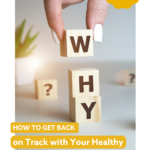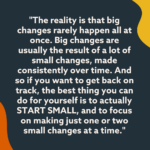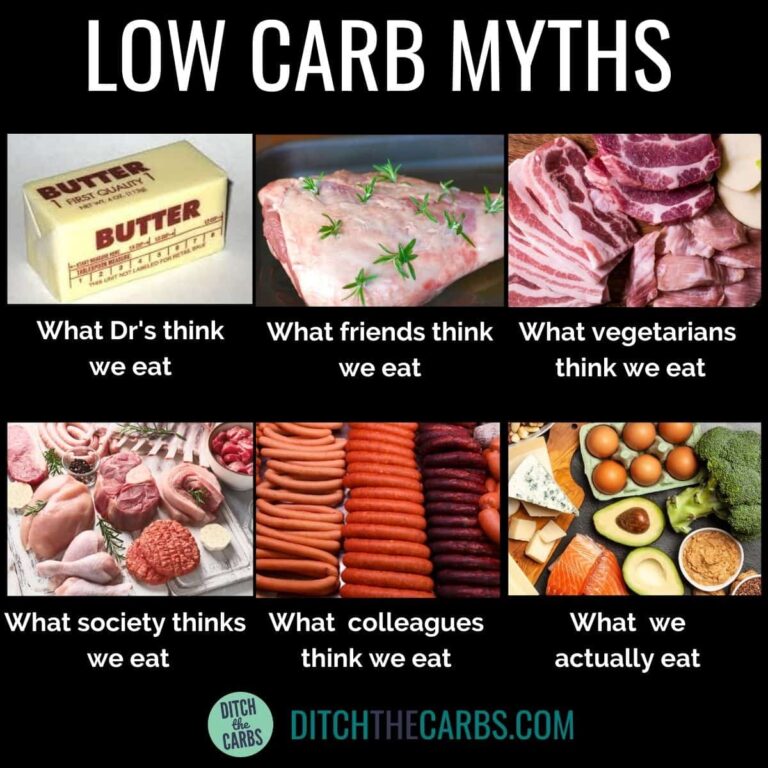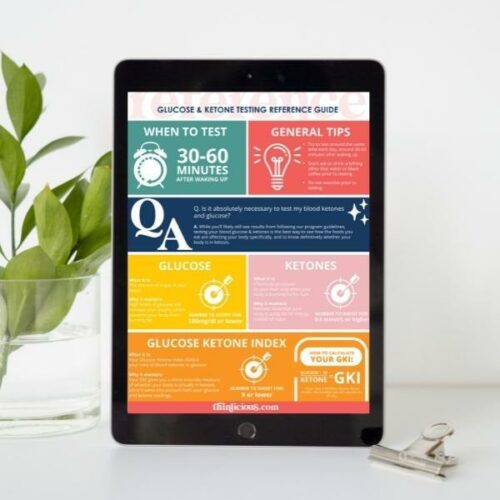Raise your hand if you feel like your summer went totally off the rails.
If it’s up right now, I can promise you that you are definitely NOT alone!
And honestly, it’s not really that surprising when you think about it.
Between the vacations and the disruptions in your normal routine, it’s easy to get off track.
Are you ready to lose weight and heal your body for life (without dieting, drugs, or making yourself miserable)?

Our free on-demand video training will walk you through how to make this THE year you set health goals…and keep them.
But that doesn’t mean you have to STAY off track.
And since Labor Day has now come and gone, and autumn is right around the corner, I thought this would be the perfect time to talk about a few super practical things you can do to, first of all, let go of any guilt and shame you might be feeling and instead set yourself up for success with healthier habits this fall.
Because the truth is that it’s not always easy to get back on the wagon if you feel like you’ve totally blown it, but it IS possible to get yourself back to a place where you’re feeling healthy and energized and motivated.
So hopefully this is the blog post that will help you do just that.

I know what it’s like to feel completely overwhelmed by all the conflicting information out there about the best way to lose weight and get healthy. I know what it’s like to feel like you just don’t have the TIME to take care of yourself, or to get in a good workout, or to cook healthy meals. I know what it’s like to feel like you’re doing everything right, and still not seeing results. And I know what it’s like to be so frustrated and discouraged by your lack of progress that you just want to give up.
Because honestly, that’s where I was a few years ago. I had been struggling with my weight for a long time—pretty much ever since my kids were born—and I had tried just about every diet and weight loss program under the sun. And nothing worked. Or at least, nothing worked for very long. I would lose a few pounds, and then gain it all back. And it was so frustrating.
And to make matters worse, I just didn’t FEEL good. I was exhausted all the time. I was constantly getting sick. I had headaches every day. I’d get this weird brain fog that made it hard for me to think or concentrate. I had all sorts of stomach issues.
And it went on for so long that I started to think it was just normal. That this was just the way things were. That it was just part of getting older.
But finally one day, I decided it was time to try something different. My daughters were now teenagers, and became acutely aware of how much they were watching me. And I didn’t want them to see me having an unhealthy relationship with food or with my body. I didn’t want them to see me starving myself on yet another diet.
And that’s when I started to really dive into the science of weight loss and metabolic health, and to learn everything I could about how our bodies actually process food, and how our hormones work, and how all of that is connected to inflammation and disease.
And the more I learned, the more I realized that so much of what we’ve been told about the right way to lose weight and get healthy is just plain WRONG. And that if I wanted to actually be successful in losing weight and getting healthy, I was going to have to unlearn a lot of the things that I thought I knew, and retrain my body to work the way it was designed to work.
And that’s how I ended up creating the Thin Adapted System, which is the program that we use here at Thinlicious. And honestly, it’s the program that I used to transform my own health and my own life.
Because once I started eating the Thinlicious way, everything changed. The weight started to come off, and it just kept coming off. I lost 40 pounds in about 6 months, and I’ve been able to keep it off ever since. In fact, my weight has even gone down a little more since then. And not only that, all of health issues went away. I had more energy than I’d had in years. I was sleeping better. My skin looked better. I just felt better. And I still do.
And that’s why I’m so passionate about this work, and about helping other women to transform their health the same way that I did. Because I know what a difference it can make. I know how it feels to be on the other side, and I want that for you too.
And that’s also why, in every episode of my podcast, I want to give you the tools and the knowledge and the inspiration to help you on your journey to better health. I want to help you cut through all the BS and get to the truth about what actually works. I want to help you understand the science behind our program, and why it’s so effective. And I want to help you implement it in a way that is actually sustainable for the long haul.
Because the reality is that losing weight and getting healthy is a PROCESS. It’s not something that happens overnight, and it’s not something that you can do for a little while and then go back to your old habits. It’s about making a real, permanent lifestyle change. It’s about changing the way you eat, and the way you think about food, and the way you take care of yourself. And I know that can be really hard, especially if you’ve been struggling with your weight for a long time, or if you have a lot of weight to lose.
But it’s also why I think it’s so important to talk about the fact that we ALL have our ups and downs on this journey. There are going to be times when you’re feeling super motivated and you’re making a lot of progress, and then there are going to be times when you get derailed, and you fall off the wagon, and you start to slip back into your old habits. And that’s okay. It happens to all of us. The key is to not let those moments of setback become permanent. The key is to find a way to get yourself back on track.
And so, with that in mind, in today’s blog post I want to talk about some practical strategies for doing just that—for getting yourself back on track after you’ve fallen off the wagon.
And honestly, it’s just as much a reminder for myself as it is for you, because frankly, it has been a crazy season and a crazy summer, and I’m SO ready to get back into the healthy habits that I know help me look and feel my absolute best.
But before we dive in, there’s just one super quick thing I want to say, and that is that if you are brand new to this blog and to Thinlicious, and you want to understand more about how our program works and how it can help you transform your health—and your life—then I would love to have you join me for my favorite training workshop. Oh, and it’s free! You can get signed up for the next one HERE. So hopefully I’ll see you there.
And with that out of the way, let’s dig in to the topic of the day and talk about how to get back on track with your healthy habits this fall!
Stop the Self-Sabotage
But before I dive right into the practical steps you can take to get back on track, I want to take a minute to talk about something that I think gets in our way more often than we’d like to admit:
Self Sabotage.
Because the truth is that losing weight and getting healthy is hard work. It’s a journey, and it’s a process. And along the way, there are going to be ups and downs. There are going to be days when you feel on top of the world, and there are going to be days when you feel like you just can’t do it. There are going to be days when you make a lot of progress, and there are going to be days when you feel like you’re moving in slow motion. And that’s okay.
But what’s not okay is when we start to get in our own way. What’s not okay is when we start to self-sabotage ourselves, and do things that we know aren’t helping us reach our goal. What’s not okay is when we start to let doubt and fear and insecurity take over, and we start to believe that we’re not good enough, or that we don’t deserve to reach our goal, or that it’s never going to happen for us.
Because often, when it comes right down to it, the only thing that’s truly holding us back is OURSELVES.
The biggest thing that’s keeping us from reaching our goal is our own self-sabotage.
And so if we can learn to recognize that, and we can learn to get out of our own way, then there’s no limit to what we can achieve.
So what does self-sabotage look like? I actually think it shows up in lots of different ways.
Diet Sabotage
First, there’s the obvious—diet sabotage.
Because obviously what we’re eating on a daily basis is the biggest factor in whether we’ll actually be successful at reaching our health and weight loss goals. And so if we’re not paying attention to what we’re eating, and we’re not fueling our bodies in the right way, then we’re basically setting ourselves up for failure.
But what happens is that we often start to self-sabotage by making excuses for ourselves. We’ll say things like, “I had a really stressful day at work, so I deserve this cookie,” or “I’ve been doing so well all week, I can afford to indulge in this pizza.” And while it’s okay to enjoy treats every now and then, constantly using them as a coping mechanism or reward is only going to hinder our progress.
Or we stop tracking our macros, telling ourselves that we don’t have time to worry about that right now, or that we already have a pretty good idea of what we’re eating and we don’t need to do that anymore, but all those little “cheats” start to slip in. And before you know it, you’ve completely derailed your progress.
But typically that diet sabotage starts out small and innocently, and then slowly starts to snowball. So it’s important to recognize those moments where you’re starting to make excuses for yourself, and nip them in the bud before they become a habit.
All or Nothing Thinking
The second big way that we tend to self-sabotage ourselves is with our THINKING. In other words, we let our own thoughts and beliefs get in the way of our success. We start to tell ourselves that we’re not good enough, or that we don’t deserve to reach our goal, or that it’s never going to happen for us. We start to let doubt and fear and insecurity take over, and we start to believe all the negative things that we tell ourselves.
And this is something that I see happen all the time, not just with weight loss, but with anything in life. We tend to be our own harshest critics, and we tend to let our own thoughts and beliefs hold us back. We start to buy into this idea of “all or nothing” thinking, where if we’re not perfect, then we’re a failure. And that’s a really dangerous mindset to get into, because it basically sets us up for failure from the beginning.
Because the truth is that there’s no such thing as perfect. And if you’re waiting until everything is perfect before you start taking action, then you’re never going to get anywhere. You have to be willing to take imperfect action. You have to be willing to take that first step, even if you’re not 100% sure of yourself. You have to be willing to be a beginner, and to make mistakes along the way.
And the more you can change your thinking, the more likely you are to actually reach your goals. Your mindset is incredibly powerful, and it can either be your biggest asset, or your biggest liability. So make sure you’re using it in a way that serves you, and not in a way that holds you back.
Habit Sabotage
And that leads us right into the third way we tend to self-sabotage—with our HABITS.
Because the reality is that we are what we repeatedly do. Our habits are what shape our lives, and our habits are what determine our success. And so if we have a lot of bad habits, or if we’re not willing to change our habits, then we’re basically just setting ourselves up for failure.
And this is something that I see happen all the time. People will come to me and say that they want to lose weight and get healthy, but they’re not willing to change any of their habits. They want to keep doing the same things they’ve always done, and they want to keep living their life the same way. And then they wonder why they’re not seeing any results.
Because the truth is that if you want to change your life, then you have to be willing to change your habits. You have to be willing to do things differently. You have to be willing to get out of your comfort zone, and to try new things. You have to be willing to make your health a priority, and to take action every single day.
And I know that can be really hard, especially if you’re trying to change a lot of habits all at once. It can be really overwhelming, and it can be really easy to get discouraged. But the reality is that you don’t have to change everything all at once. You just have to be willing to take it one step at a time, and to focus on changing one habit at a time.
But habits is a big one.
Mindset Sabotage
And the fourth big way we tend to self-sabotage is with our MINDSET.
And I know that might sound a little bit redundant, since we already talked about changing your thinking and your beliefs. But when I talk about mindset, I’m really talking about your overall approach and attitude towards life, and how that impacts your ability to reach your goals.
In other words, I’m talking about whether you have a growth mindset or a fixed mindset. And if you’re not familiar with those terms, a growth mindset is when you believe that your abilities and intelligence can be developed and improved over time, through hard work, learning, and perseverance. In other words, you believe that you have the power to change and grow.
On the other hand, a fixed mindset is when you believe that your abilities and intelligence are static and unchangeable. In other words, you believe that you are who you are, and there’s nothing you can do to change that.
And the reality is that your mindset has a huge impact on your ability to reach your goals. If you have a growth mindset, then you’re much more likely to be successful, because you believe that you have the power to change and grow. You’re willing to put in the work, and you’re willing to take risks. And even when things get tough, you’re able to pick yourself back up and keep going.
But if you have a fixed mindset, then you’re much more likely to self-sabotage. You’re much more likely to give up when things get hard, because you believe that there’s nothing you can do to change the situation. You’re much more likely to make excuses, and to blame other people or outside circumstances. And you’re much more likely to let doubt and fear and insecurity creep in, because you believe that you’re not capable of reaching your goal.
X Steps for Getting Back on Track
So those are the four big ways we tend to self-sabotage our health—with our diet, with our all or nothing thinking, with our habits, and with our mindset. And it’s important to be aware of all of those tendencies.
But then the question really becomes—what can you do about it? How do get back on track when you’ve been sabotaging yourself?
Acknowledge the Problem
The first step to getting back on track after you’ve fallen off the wagon is to actually acknowledge that there IS a problem. And I know that might sound a little bit obvious, but I think it’s actually a really important first step, because so often when we start to slip back into our old habits, we don’t want to admit it to ourselves. We want to just keep burying our head in the sand and pretending like everything is fine, even when we know deep down that it’s not.
And I’ve definitely been guilty of this in the past. I’ll start to notice that my clothes are feeling a little bit tighter, or that I’m not sleeping as well, or that I’m feeling more tired and sluggish, and I’ll just keep telling myself that it’s no big deal. I’ll tell myself that I’m still doing okay, and that I’ll get back on track soon, and that it’s not really a problem. And I’ll just keep ignoring all the warning signs.
But the truth is that the longer you ignore the problem, the bigger it’s going to get, and the harder it’s going to be to actually do something about it. And so the first step is to just be honest with yourself and acknowledge that you’ve fallen off the wagon, and that you need to make a change. You need to take a good, hard look at where you’re at right now, and where you want to be, and you need to be willing to admit that there’s a gap.
And I think it can also be really helpful to actually write this down. Take some time to do a little self-assessment and really think about where you’re at in terms of your health and your weight loss journey. Think about what your goals are, and where you want to be. And then think about where the gaps are. What are the things that you’re not doing, or that you’ve stopped doing, that are keeping you from reaching those goals? What are the old habits that you’ve slipped back into? What are the things that you need to change?
Get it out of your head and onto paper, so that you can really see it and look at it and start to make a plan for how to move forward. Because the truth is that you can’t change what you’re not willing to acknowledge. You have to be honest with yourself about where you’re at, and where you want to be, and what’s standing in the way.
So that’s the first step. Just acknowledge the problem, and be honest with yourself about where you’re at, and where you want to be.
Reconnect with Your Why
The second step to getting back on track after you’ve fallen off the wagon is to actually take some time to reconnect with your WHY. And I know that might sound a little bit cliche, but honestly, I think it’s one of the most important things you can do, not just in this situation, but in life in general.
Because the reality is that we are all driven by our WHY. We are all motivated by our reasons for doing things, and when we lose sight of those reasons, it’s really easy to slip back into our old habits and to stop making progress. But when we can stay connected to our WHY, and keep it at the forefront of our mind, it becomes a lot easier to stay motivated and to keep moving forward, even when things get tough.
So take some time to really think about what your WHY is. Why did you start this journey in the first place? What were the things that were motivating you to make a change? What were the things that you wanted to be different in your life? What were the things that you were hoping to gain, or to avoid? What were the things that were important to you?
And again, actually write this down. Get it out of your head and onto paper, so that you can really see it and look at it and remind yourself of it on a regular basis. Because the truth is that we all have a tendency to forget. We get busy, and we get distracted, and we start to lose sight of the things that are really important to us. And so we have to be intentional about keeping those things front and center in our mind.
And I think it can also be really helpful to take some time to actually visualize what your life will look like when you reach your goals. Really try to paint a picture in your mind of what that will be like. What will it feel like to have more energy, and to not be out of breath all the time? What will it feel like to be able to wear whatever you want, and to feel confident in your own skin? What will it feel like to not have to worry about all the health issues that are associated with being overweight and out of shape? What will it feel like to be able to do all the things that you want to do, and to not be held back by your weight?
And I know that for a lot of us, this can be a really emotional process. Because the truth is that our WHY is usually tied to our deepest desires and our deepest fears. It’s usually tied to the things that we want more than anything, and the things that we’re most afraid of losing. And so it’s okay to let yourself feel those emotions. It’s okay to cry, or to get angry, or to get really fired up. Because those emotions are what will ultimately drive you to take action.
So that’s the second step. Take some time to really reconnect with your WHY, and to remind yourself of all the reasons why this journey is important to you. And then keep those reasons front and center in your mind, and let them be the thing that motivates you to keep moving forward, even when it’s hard.

Start Small
The third step to getting back on track after you’ve fallen off the wagon is to actually START SMALL. And I know that for a lot of us, this can be the hardest part, because we have a tendency to want to do ALL THE THINGS, and to do them all at once. We want to go from zero to a hundred in the blink of an eye, and to completely overhaul our entire life and our entire routine in one fell swoop. And then when we can’t sustain that level of change, we get discouraged and we give up.
But the reality is that big changes rarely happen all at once. Big changes are usually the result of a lot of small changes, made consistently over time. And so if you want to get back on track, the best thing you can do for yourself is to actually START SMALL, and to focus on making just one or two small changes at a time.
And the key word here is SMALL. I’m talking about changes that are so small, they almost feel insignificant. Changes that are so small, you don’t even really have to think about them. Changes that are so small, you can do them without a lot of effort or willpower. Because the truth is that willpower is a finite resource, and if you’re relying on it to make big changes, you’re probably not going to be very successful.

So what are some examples of small changes that you can make? Well, it really depends on where you’re at, and what your goals are, but here are a few ideas to get you started.
If you’ve been eating a lot of processed junk food and sugar, and you’re feeling like you need to get back to eating a more whole foods based diet, then maybe your first small change could be to just focus on adding more vegetables to your meals. You don’t have to completely cut out all the junk right away, but just start by adding more of the good stuff.
Or if you’ve been struggling to find the time to cook healthy meals, then maybe your first small change could be to just start meal planning. Even if you’re not actually cooking the meals yet, just having a plan in place can make a big difference.
Or if you’ve been feeling really overwhelmed and stressed out, and you know that you need to find a way to take better care of yourself, then maybe your first small change could be to just start by taking a few minutes every day to do some deep breathing or meditation, or to go for a short walk.
Or if you’ve been skipping your workouts, then maybe your first small change could be to just commit to doing 10 minutes of exercise every day. It doesn’t have to be a lot, but just getting in the habit of moving your body on a regular basis can help to build momentum.
So those are just a few examples, but like I said, it really depends on where you’re at and what your goals are. The key is to just start with one or two small changes, and to focus on being consistent with those changes before you try to add anything else.
And I think it can also be really helpful to actually write these changes down, and to make a plan for how you’re going to implement them. So take some time to think about what your first small changes will be, and then write them down, and put them on your calendar, or on a sticky note on your bathroom mirror, or somewhere where you’ll see them every day. And then just focus on being consistent with those changes, and on building momentum, one small step at a time.
So that’s the third step. START SMALL, and focus on making just one or two small changes at a time, and on being consistent with those changes before you try to add anything else.
Get Support
The fourth step to getting back on track after you’ve fallen off the wagon is to make sure you’re actually getting the support and accountability you need to be successful.
And I know that for a lot of us, this can be a really scary and vulnerable thing to do, because it means that we have to actually ADMIT to someone else that we’ve been struggling, and that we need help. And that can be really hard, especially if you’re used to being the one that everyone else looks to for support.
But the reality is that we all need help and support from time to time. We all need someone to cheer us on, and to hold us accountable, and to help us stay on track. And so if you’re feeling like you’ve been struggling to get back on track, then finding a coach or an accountability partner or a supportive community might be just the thing you need.
I think the most important thing is to find someone who is going to be supportive and non-judgmental, but who is also going to be willing to give you a little tough love when you need it. You want someone who is going to be there to cheer you on, but who is also going to be willing to ask the hard questions, and to hold you accountable when you start to slip back into your old habits.
And that’s also one of the big things that I think makes our program so helpful. Because that support is built in. But you also have to be willing to lean into it.
So that’s the fourth step. Get the support you need to get back on track.
Forgive Yourself and Commit to Moving Forward
The fifth and final step for getting back on track is perhaps one of the trickiest: forgiving yourself and committing to moving forward.
The truth is that we all mess up from time to time—it’s sort of the unspoken rule of being human.
But you can’t go backwards. What’s done is done. You can’t change the past.
But you can change the future.
So re-commit to your goals and to moving forward, and then let go of any anger or disappointment in yourself that isn’t actually serving you.
Getting healthy is a marathon, not a sprint.
And big goals never happen all at once. They are only the result of small steps taken consistently over time.
So commit to taking the small steps you need to, starting today.
And then watch what happens.
Because I know you’ve got this friend, and I believe in you.
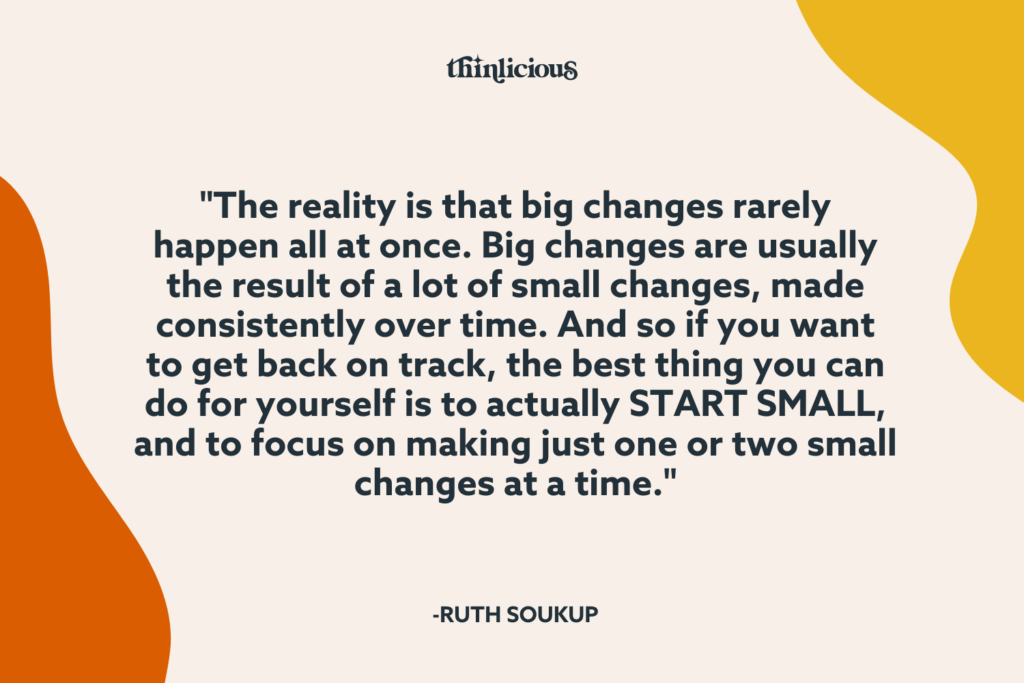
What if you could actually take control of
your health in just 10 days?
It’s not your fault you can’t lose weight as a woman over 40 even though you’ve likely tried literally everything. Your metabolism probably feels broken and your hormones are likely all out of whack.
But you can fix it all with ONE simple change: eliminate sugar. We make it super easy with daily lessons teaching you the science behind what makes us gain weight in our midlife and beyond! Are you ready to get started now?


